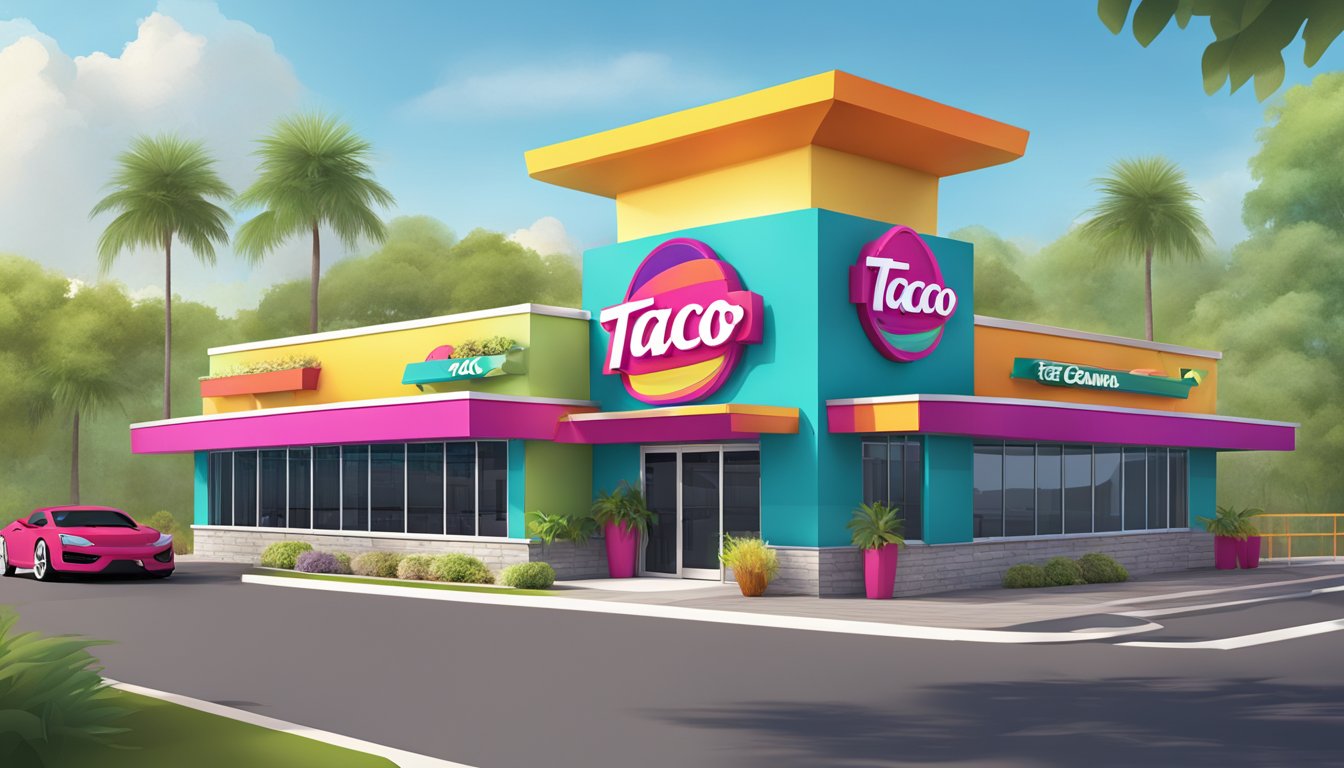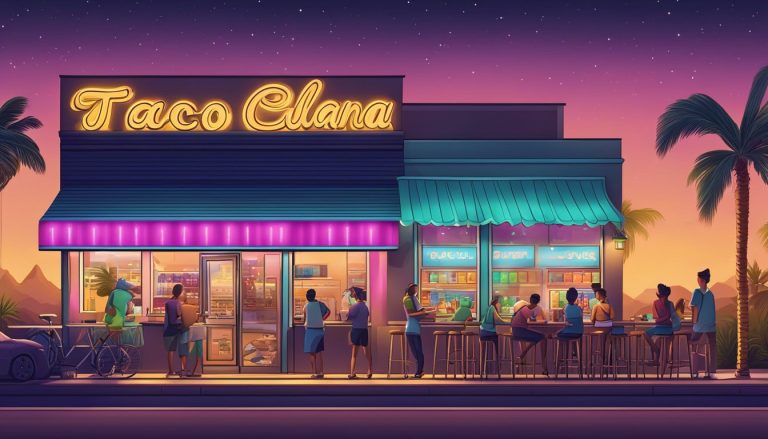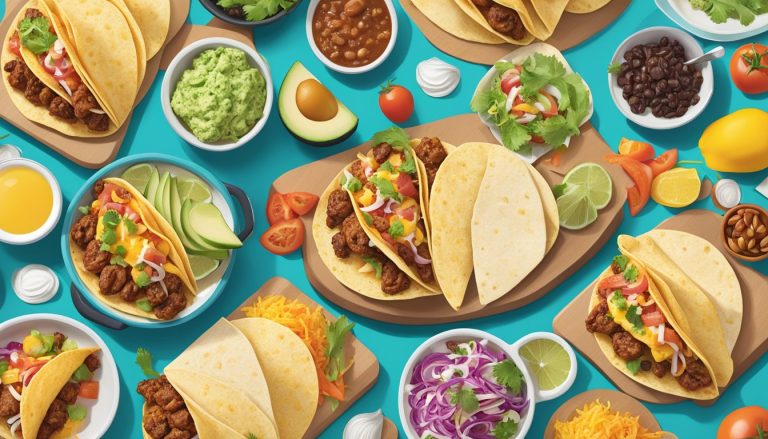Taco Cabana, a Tex-Mex fast-casual restaurant chain, has undergone significant transformations in its restaurant design since its inception in 1978. From its humble beginnings as a converted Dairy Queen in San Antonio, Texas, the brand has evolved to embrace modern aesthetics while staying true to its Mexican-inspired roots.
Taco Cabana’s latest restaurant prototype draws inspiration from the interior of Mexico, featuring authentic-style architecture and artwork created by local Alamo City artists. This new design approach aims to create a more immersive dining experience that resonates with customers and pays homage to the brand’s cultural influences.
The company’s commitment to innovation extends beyond aesthetics. Taco Cabana has introduced a smaller restaurant prototype, adapting to changing consumer preferences and market demands. This move demonstrates the brand’s agility and willingness to embrace new concepts as it continues to grow and evolve in the competitive fast-casual dining landscape.
The History of Taco Cabana
Taco Cabana’s journey from a single location to a widespread chain spans over four decades. The company’s growth reflects its adaptability and commitment to its Tex-Mex roots.
Establishment and Early Years
Felix Stehling founded Taco Cabana in September 1978. The first restaurant opened at the corner of San Pedro and Hildebrand Avenue in Midtown San Antonio. Stehling repurposed a vacant Dairy Queen building, initially intending to use it for additional parking for his bar across the street.
The open-air design of the existing structure inspired Taco Cabana’s signature patio dining areas. This unique feature became a hallmark of the brand, setting it apart from other fast-food chains.
Taco Cabana quickly gained popularity for its fresh, made-to-order Tex-Mex cuisine and 24-hour service. The success of the first location led to rapid expansion within San Antonio.
Expansion and Franchising
By the 1980s, Taco Cabana began expanding beyond San Antonio. The chain opened locations in other Texas cities, capitalizing on the growing demand for quick-service Tex-Mex food.
In the 1990s, Taco Cabana entered new markets in Oklahoma and New Mexico. The company’s growth strategy included a mix of company-owned restaurants and franchises.
Taco Cabana went public in 1992, fueling further expansion. The chain continued to refine its concept, introducing drive-thru service and expanding its menu offerings.
Milestones: From Babcock Road to Widespread Chain
1978: First Taco Cabana opens in San Antonio
1986: Second location opens on Babcock Road
1992: Taco Cabana goes public
2001: Carrols Corporation acquires Taco Cabana
2012: Fiesta Restaurant Group spins off from Carrols
Taco Cabana celebrated its 44th birthday in 2022, marking over four decades of serving Tex-Mex cuisine. The chain now operates over 140 locations across Texas, Oklahoma, and New Mexico.
Despite changes in ownership, Taco Cabana has maintained its commitment to fresh ingredients and its signature pink color scheme. The company continues to innovate, adapting its restaurant designs and menu to meet evolving customer preferences.
Architectural Evolution
Taco Cabana’s restaurant design has undergone significant transformations over the years, reflecting changing consumer preferences and brand evolution. The architectural journey spans from its original Tex-Mex roots to modern, streamlined concepts.
Original Design and Tex-Mex Charm
Taco Cabana’s initial restaurant design embraced a vibrant Tex-Mex aesthetic. The exteriors featured stucco walls painted in warm, earthy tones reminiscent of Mexican adobe architecture. Colorful awnings and neon signage added a festive touch to the facades.
Inside, the decor included rustic wooden furniture, Mexican-inspired artwork, and decorative tiles. The open kitchen concept allowed customers to watch their food being prepared fresh. Covered patios with string lights created an inviting outdoor dining atmosphere.
This original design established Taco Cabana’s identity as a casual, family-friendly Tex-Mex eatery.
Adopting the TC Conversion Prototype
As Taco Cabana expanded, it introduced the TC Conversion Prototype to update existing locations and guide new builds. This design phase focused on modernizing the brand’s look while maintaining its Tex-Mex heritage.
Key features of the TC Conversion Prototype included:
- Updated exterior color schemes with bolder hues
- Sleeker signage and lighting elements
- Redesigned dining areas with contemporary furnishings
- Enhanced patio spaces with improved seating and shade structures
The prototype aimed to create a more polished appearance while preserving the welcoming atmosphere that customers associated with the brand.
TC 3.0: The Next-Generation Building Prototype
Taco Cabana’s latest architectural evolution is embodied in the TC 3.0 prototype, unveiled in Spring, Texas in 2023. This design represents a significant leap forward in the brand’s visual identity and operational efficiency.
TC 3.0 features:
- A compact 2,541 square-foot footprint
- Sleek, modern exterior with clean lines and updated color palette
- 375-square-foot patio for outdoor dining
- Dynamic lighting package to enhance ambiance
- Elevated decor elements inspired by interior Mexico
Developed in collaboration with Hospitality Design Group, TC 3.0 balances functionality with aesthetics. The streamlined design reduces initial investment costs for franchise partners while creating an inviting space for customers.
Signature Design Elements

Taco Cabana’s restaurant design incorporates several distinctive features that define its brand identity and customer experience. These elements blend traditional Mexican influences with modern aesthetics.
Iconic Pink Color and Branding Marquee
Taco Cabana’s signature pink color plays a central role in its visual identity. The vibrant hue appears prominently on exterior signage and interior accents. Recent redesigns have integrated the pink into a more contemporary black-dominated color scheme, creating a striking contrast.
The brand’s logo, featuring a pink TC oval, remains a key element of the restaurant’s facade. Modernized lighting and branding elements now complement the iconic pink, enhancing visibility and curb appeal.
New locations showcase updated exterior designs that maintain brand recognition while presenting a fresh, modern look.
Patios and Outdoor Dining Ambiance
Outdoor patios are a hallmark of Taco Cabana restaurants. These spaces provide a comfortable, relaxed atmosphere for dining and socializing.
Many locations feature covered patios with ample seating, allowing guests to enjoy their meals in an open-air setting. Patio areas often include decorative elements like string lights or planters to create a welcoming ambiance.
The emphasis on outdoor dining spaces reflects the brand’s Tex-Mex heritage and caters to customers who prefer al fresco experiences.
Interior Layout and Tortilla-Making Visibility
Taco Cabana’s interior design focuses on creating an efficient, inviting dining area. The layout typically includes a mix of booth and table seating to accommodate various group sizes.
A standout feature is the visible tortilla-making station. This allows customers to watch fresh tortillas being prepared, adding an element of culinary theater to the dining experience.
The salsa bar, a beloved feature, has made a return in newer designs. This self-serve station offers a variety of fresh salsas and condiments, allowing guests to customize their meals.
Counter areas and pick-up zones are strategically placed to facilitate smooth service for both dine-in and takeout customers.
Culinary and Service Innovation

Taco Cabana has implemented key changes to enhance its menu offerings and cooking methods. These innovations aim to elevate the quality and authenticity of its Tex-Mex cuisine.
Integrating Chargrills for Quality Cuisine
Taco Cabana introduced chargrills to improve the flavor profile of its grilled items. This cooking method imparts a distinct smoky taste to meats and vegetables. The chargrills allow for faster cooking times, ensuring food reaches customers quicker and hotter.
TC Innovation teams have developed new recipes specifically for chargrill preparation. These include marinated fajitas, grilled chicken, and flame-kissed vegetables. The chargrills also enable the creation of unique limited-time offerings, keeping the menu fresh and exciting.
Enhancing the Tex-Mex Offerings
Taco Cabana has expanded its Tex-Mex menu to include more authentic and diverse options. New additions feature regional specialties from various parts of Mexico and Texas. The chain now offers a wider selection of tacos, including street-style varieties with traditional toppings.
Fresh, made-from-scratch salsas and sauces have become a focal point. Taco Cabana regularly introduces new flavor combinations to complement its dishes. The restaurant has also improved its tortilla recipe, now producing softer, more pliable wraps for its burritos and quesadillas.
Operational Growth and Adaptation

Taco Cabana has implemented strategic operational changes to enhance efficiency and accessibility. These adaptations have positioned the brand for steady growth and increased profitability in the competitive quick-serve industry.
Drive-Thru and Quick-Serve Efficiency
Taco Cabana has prioritized drive-thru optimization to meet evolving customer needs. The company has invested in streamlined kitchen processes and menu simplification to reduce wait times and improve order accuracy.
Digital menu boards and mobile ordering integration have further enhanced the drive-thru experience. These technologies allow for real-time menu updates and personalized recommendations.
Taco Cabana has also implemented dual drive-thru lanes at select locations to manage high traffic volumes more effectively. This design change has significantly reduced queue times during peak hours.
Walk-Up Window and Accessibility
To cater to pedestrian traffic and enhance convenience, Taco Cabana has incorporated walk-up windows into many of its restaurant designs. This feature allows customers to quickly place and pick up orders without entering the main dining area.
The walk-up window concept has proven particularly successful in urban locations and near college campuses. It accommodates customers seeking grab-and-go options during lunch breaks or late-night hours.
Taco Cabana has ensured these windows are ADA-compliant, making them accessible to all customers. The addition of digital ordering kiosks near walk-up windows has further streamlined the process.
The Role of YTC Enterprises in Brand Expansion
YTC Enterprises has played a crucial role in Taco Cabana’s recent growth and adaptation strategies. As the parent company, YTC has provided resources and expertise to drive the brand’s expansion.
Under YTC’s guidance, Taco Cabana has embraced franchising as a key growth strategy. This approach allows for rapid market penetration while leveraging local franchisees’ knowledge and capital.
YTC has also facilitated partnerships with experienced franchising professionals like John Ramsay. His expertise from brands such as Noodles & Company and Jack in the Box has been invaluable in developing Taco Cabana’s franchise program.
The company has focused on strategic site selection and prototype development to ensure new franchised locations are set up for success. This includes the introduction of a smaller, more cost-effective restaurant design to lower initial investment for franchise partners.
Emerging Trends in Hospitality Design

Hospitality design continues to evolve, with restaurants embracing innovative concepts to create unique dining experiences. Taco Cabana’s approach reflects broader industry shifts towards more engaging and immersive environments.
Embracing Hospitality Design Innovations
Maximalism is making a comeback in restaurant design. Bold colors, rich textures, and eye-catching patterns are replacing minimalist aesthetics. Taco Cabana’s new interiors feature vibrant Mexican-inspired murals and colorful tile work.
Sustainable materials are gaining prominence. Reclaimed wood, recycled plastics, and locally-sourced furnishings reduce environmental impact while adding character. LED lighting systems improve energy efficiency and allow for customizable ambiance.
Technology integration is reshaping dine-in experiences. Digital menu boards, tableside ordering tablets, and mobile payment options streamline service. Some restaurants are experimenting with augmented reality to provide interactive menu presentations.
Creating a Unique Dining Experience
Restaurants are focusing on creating memorable, Instagram-worthy spaces. Taco Cabana has introduced photo-friendly neon signage and artistic installations that encourage social media sharing.
Open kitchens continue to gain popularity, allowing guests to watch meal preparation. This trend adds transparency and entertainment value to the dining experience.
Flexible seating arrangements accommodate different group sizes and preferences. Communal tables, booth seating, and outdoor patios offer varied dining environments.
Themed design elements tell a brand’s story. Taco Cabana incorporates authentic Mexican decor and artwork to reinforce its cultural roots and menu offerings.
Expansion Into New Markets

Taco Cabana’s growth strategy has focused on expanding beyond its Texas roots into new markets while maintaining its Tex-Mex heritage. The company has targeted key areas for expansion, including major Texas cities and neighboring states.
Entering the Houston Market
Taco Cabana established a strong presence in Houston, one of Texas’ largest metropolitan areas. The company converted existing restaurant locations and built new ones to serve the diverse Houston market.
Taco Cabana tailored its menu and restaurant designs to appeal to Houston’s multicultural population. The expansion into Houston allowed the brand to refine its urban market strategy.
Outreach to Colorado and Beyond
After saturating key Texas markets, Taco Cabana set its sights on neighboring states. Colorado emerged as a prime target for expansion due to its growing population and appetite for Tex-Mex cuisine.
The company developed a franchising program to fuel growth in Colorado and other states like Arizona, Arkansas, and Missouri. This strategy allows Taco Cabana to leverage local franchisees’ market knowledge while maintaining brand consistency.
TC Heritage and Texas Location Importance
While expanding to new markets, Taco Cabana remains committed to its Texas roots. The company’s Texas locations serve as flagships, showcasing the brand’s heritage and authentic Tex-Mex offerings.
Taco Cabana carefully balances growth with preserving its core identity. New locations outside Texas incorporate design elements that pay homage to the brand’s San Antonio origins.
The company views its Texas presence as crucial for maintaining brand authenticity as it enters new territories. This strategy helps Taco Cabana attract customers seeking genuine Tex-Mex flavors in markets beyond the Lone Star State.
Promotional Strategy and Customer Engagement

Taco Cabana has implemented targeted promotional strategies and innovative restaurant designs to boost customer engagement and reinforce its brand identity. The company focuses on highlighting its strengths in quality food and beverages while creating inviting spaces for patrons to enjoy.
Celebrating Happy Hour and Margarita Leadership
Taco Cabana positions itself as a “Margarita Headquarters,” capitalizing on its popular drink offerings. The chain promotes daily happy hour specials, featuring discounted margaritas and appetizers. This strategy attracts customers during traditionally slower afternoon hours and helps establish Taco Cabana as a go-to spot for after-work drinks.
The restaurant’s expansive margarita menu includes both classic and innovative flavors, catering to diverse tastes. Seasonal promotions often spotlight limited-time margarita flavors, encouraging repeat visits from curious patrons.
Taco Cabana also emphasizes its commitment to quality by using fresh ingredients in its margaritas and promoting house-made mixers.
Ground-Up Restaurant Prototype Design and Community Impact
Taco Cabana has developed a ground-up restaurant prototype design that reflects its Tex-Mex heritage and enhances the dining experience. The new layout features open-air patios, creating a welcoming atmosphere for customers to enjoy their meals and drinks outdoors.
These redesigned spaces are tailored to foster community gatherings and social interactions. Large communal tables and comfortable seating arrangements encourage groups to linger and socialize.
The updated design also incorporates elements of local culture and art, helping each location feel connected to its neighborhood. This approach aims to position Taco Cabana restaurants as community hubs rather than just quick-service establishments.




